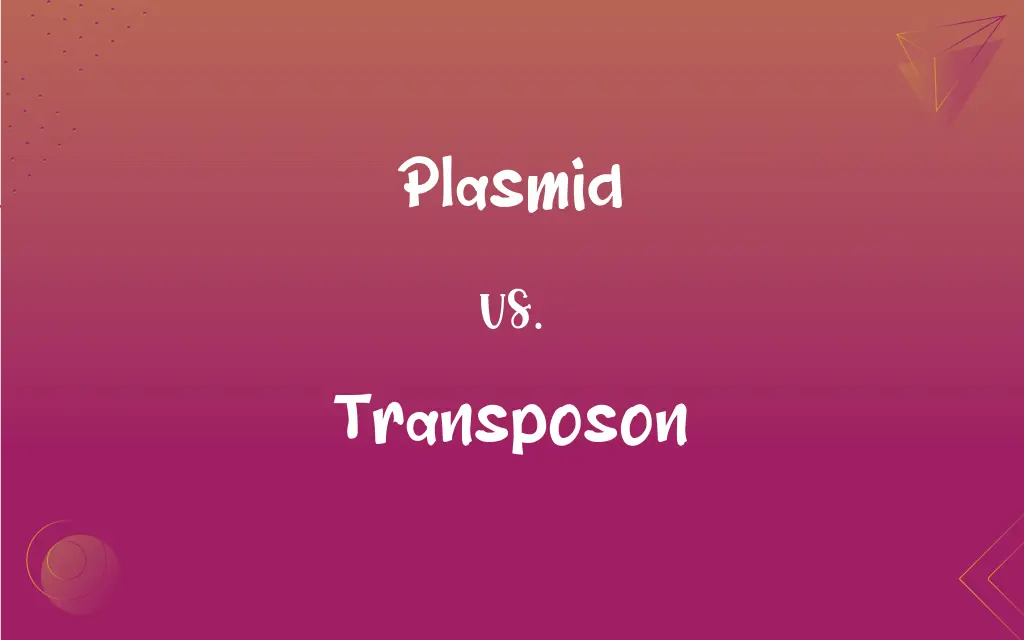Plasmid vs. Transposon: What's the Difference?
Edited by Aimie Carlson || By Harlon Moss || Published on February 22, 2024
A plasmid is a small, circular DNA molecule separate from chromosomal DNA, often found in bacteria; a transposon is a DNA sequence that can change its position within the genome.

Key Differences
Plasmids are extrachromosomal DNA elements, typically circular and found in bacteria, while transposons, also known as "jumping genes," are DNA sequences that can move within the genome.
Plasmids can replicate independently of the host chromosome and often carry genes beneficial to the host, such as antibiotic resistance; transposons, on the other hand, insert themselves into various locations within the genome, potentially causing mutations.
Plasmids are used in genetic engineering as vectors for gene transfer, whereas transposons are studied for their role in genetic diversity and evolution.
The size of plasmids varies greatly, but they are generally smaller than chromosomal DNA; transposons vary in size too but are segments within larger DNA strands.
Plasmids can be transferred between cells, particularly in bacteria, enabling the spread of certain traits; transposons do not transfer between cells but can replicate or move within the cell's genome.
ADVERTISEMENT
Comparison Chart
Basic Definition
Small, circular, extrachromosomal DNA molecule
DNA sequence that can change its position in genome
Location
Independent of chromosomes, often in bacteria
Within the chromosomes
Function
Often carries beneficial genes, like antibiotic resistance
Causes mutations, contributes to genetic diversity
Usage in Biotechnology
Used as vectors in gene transfer
Studied for genetic variation and evolution
Mobility
Can be transferred between cells
Moves within the cell's genome
ADVERTISEMENT
Plasmid and Transposon Definitions
Plasmid
A circular DNA molecule separate from chromosomal DNA.
Scientists used a plasmid to introduce new genes into bacterial cells.
Transposon
A DNA sequence capable of changing its position within the genome.
The transposon moved to a new location in the DNA, altering gene expression.
Plasmid
Replicates independently in a cell.
The plasmid replicates in the bacterium, independent of its chromosomal DNA.
Transposon
Often disrupts or alters the functions of genes.
A transposon insertion caused a mutation in the gene.
Plasmid
Transferrable between bacterial cells.
The plasmid was transferred between bacteria, spreading the resistance genes.
Transposon
Can cause genetic diversity.
Transposons contribute to genetic variation in the population.
Plasmid
Often carries genes beneficial to its host.
This plasmid provides the bacteria with antibiotic resistance.
Transposon
Present in both prokaryotic and eukaryotic organisms.
Transposons were found in the genome of both bacteria and humans.
Plasmid
Used in genetic engineering.
The plasmid was engineered to carry a human gene for insulin production.
Transposon
Studied for their role in evolution.
Researchers are examining how transposons have influenced evolutionary processes.
Plasmid
A circular, double-stranded unit of DNA that replicates within a cell independently of the chromosomal DNA. Plasmids are most often found in bacteria and are used in recombinant DNA research to transfer genes between cells.
Transposon
A segment of DNA that is capable of moving into a new position within the same or another chromosome or plasmid. Also called jumping gene.
Plasmid
(cytology) A loop of double-stranded DNA that is separate from and replicates independently of the chromosomes, most commonly found in bacteria, but also in archaeans and eukaryotic cells, and used in genetic engineering as a vector for gene transfer.
Transposon
(genetics) A segment of DNA that can move to a different position within a genome, or to the genome of another species.
Plasmid
A piece of DNA, usually circular, functioning as part of the genetic material of a cell, not integrated with the chromosome and replicating independently of the chromosome, but transferred, like the chromosome, to subsequent generations of daughter cells. In bacteria, plasmids often carry the genes for antibiotic resistance; they are exploited in genetic engineering as the vehicles for introduction of extraneous DNA into cells, to alter the genetic makeup of the cell. The cells thus altered may produce desirable proteins which are extracted and used; in the case of genetically altered plant cells, the altered cells may grow into complete plants with changed properties, as for example, increased resistance to disease.
Transposon
A segment of DNA that can become integrated at many different sites along a chromosome (especially a segment of bacterial DNA that can be translocated as a whole)
Plasmid
A small cellular inclusion consisting of a ring of DNA that is not in a chromosome but is capable of autonomous replication
FAQs
What is a transposon?
A DNA sequence that can change its position within a genome.
Do transposons move between cells?
No, they move within a cell's genome.
What is a plasmid?
A small, circular DNA molecule, separate from chromosomal DNA.
Can plasmids exist outside of cells?
No, they are typically found within cells.
Are plasmids found in humans?
No, they are primarily found in bacteria.
Are plasmids used in genetic engineering?
Yes, as vectors for gene transfer.
Can plasmids carry multiple genes?
Yes, they can carry several genes.
Can transposons aid in evolutionary studies?
Yes, they are important in studying evolution.
Can transposons be found in human DNA?
Yes, they are present in both prokaryotic and eukaryotic organisms.
Can transposons create new genes?
They can activate or deactivate existing genes, but don't create new ones.
Do transposons contribute to genetic diseases?
They can, by causing mutations in genes.
Do plasmids replicate independently?
Yes, they replicate independently of chromosomal DNA.
Can plasmids be transferred between different species?
Yes, especially among bacteria.
How are plasmids used in medicine?
They are used to produce proteins like insulin in bacteria.
Do transposons have a role in cancer?
They can play a role in cancer development by disrupting gene functions.
Are all transposons active?
No, some are inactive or "silent" within the genome.
How do plasmids benefit bacteria?
They often carry genes that enhance survival, like antibiotic resistance.
Are transposons always harmful?
No, they can also contribute to genetic diversity.
Are all plasmids circular?
Most are circular, but some can be linear.
Do transposons help in gene therapy?
They have potential uses in gene therapy research.
About Author
Written by
Harlon MossHarlon is a seasoned quality moderator and accomplished content writer for Difference Wiki. An alumnus of the prestigious University of California, he earned his degree in Computer Science. Leveraging his academic background, Harlon brings a meticulous and informed perspective to his work, ensuring content accuracy and excellence.
Edited by
Aimie CarlsonAimie Carlson, holding a master's degree in English literature, is a fervent English language enthusiast. She lends her writing talents to Difference Wiki, a prominent website that specializes in comparisons, offering readers insightful analyses that both captivate and inform.







































































